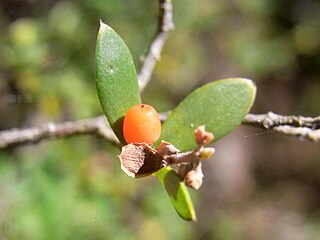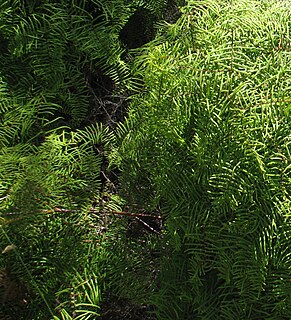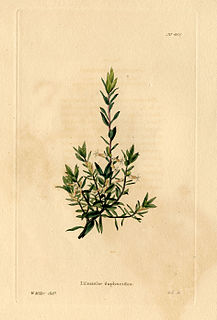
Grevillea is a diverse genus of about 360 species of evergreen flowering plants in the family Proteaceae, native to rainforest and more open habitats in Australia, New Guinea, New Caledonia, Sulawesi and other Indonesian islands east of the Wallace Line. It was named in honour of Charles Francis Greville, an 18th century patron of botany and co-founder of the Royal Horticultural Society. The species range from prostrate shrubs less than 50 cm (20 in) tall to trees 35 m (115 ft) tall. Common names include grevillea, spider flower, silky oak and toothbrush plant. Closely related to the genus Hakea, the genus gives its name to the subfamily Grevilleoideae.

Hakea is a genus of about 150 species of plants in the Family Proteaceae and are endemic to Australia. They are shrubs or small trees with leaves that are sometimes flat, otherwise circular in cross section in which case they are sometimes divided. The flowers are usually arranged in groups in leaf axils and resemble those of other genera, especially Grevillea. Hakeas have woody fruit which distinguishes them from grevilleas which have non-woody fruit which release the seeds as they mature. Hakeas are found in every state of Australia with the highest species diversity being found in the south west of Western Australia.

Exocarpos is a genus of flowering shrubs and small trees in the sandalwood family, Santalaceae. They are found throughout Southeast Asia, Australia and the Pacific Islands.

Lechenaultia is a genus of plants in the family Goodeniaceae. Some species of this genus are used as ornamental plants, in particular L. biloba, L. formosa and L. macrantha.Lechenaultia species are diverse in form: they may be woody or herbaceous, upright or prostrate with leaves flat, needle-like or virtually absent in mature plants. The genus differs from other Goodeniaceae in the structure of the stigma and the fertilization mechanism. They are found in Australia and New Guinea.

Acrotriche is a genus of flowering plants in the family Ericaceae. Species occur in all states of Australia. They include:

Sprengelia is a genus of shrubs in the family Ericaceae.

Styphelia is a genus of shrubs in the family Ericaceae and is endemic to Australia. Most have minute or small leaves with a sharp tip, single, tube-shaped flowers arranged in leaf axils and with the ends of the petals rolled back with hairs in the inside of the tube.

Gleichenia is a genus of ferns. Its closest relative is the genus Stromatopteris, restricted to New Caledonia.

Lissanthe is a genus of shrubs in the family Ericaceae. The genus is endemic to Australia.

Richea is a genus of 11 species of flowering plants in the family Ericaceae. Nine of the species are endemic to Tasmania and the other two are endemic to the south-east of the Australian mainland.

Brachyloma is a genus of shrubs in the family Ericaceae. The genus is endemic to Australia.

Triplarina is a genus of 7 species of shrubs in the family Myrtaceae. They occur in New South Wales and Queensland in Australia.

Isopogon ceratophyllus, commonly known as the horny cone-bush or wild Irishman, is a plant of the family Proteaceae that is endemic to the coast in Victoria, South Australia and on the Furneaux Group of islands in Tasmania. It is a small woody shrub that grows to 100 cm high with prickly foliage. It is extremely sensitive to dieback from the pathogen Phytophthora cinnamomi

Lomatia myricoides, commonly known as the river lomatia, is a shrub native to New South Wales and Victoria in southeastern Australia.

Monotoca elliptica, the tree broom heath, is a plant in the family Ericaceae, found in south-eastern Australia.
Dielsiodoxa is a small genus of flowering plants in the family Ericaceae. The species, all endemic to Western Australia, include:

Agastachys odorata, commonly known as the white waratah, is the sole member of the genus Agastachys in the protea family. It is an evergreen shrub to small tree and is endemic to the heaths and button grass sedgelands of western Tasmania. It occurs most often in moist heath and scrub and occasionally in the alpine regions, but generally prefers well-drained but poor soils. It can grow in some rainforests where it forms a small tree but is normally a shrub in all other situations. The heaviest concentrations are along the island's south coast. Its leaves are dark green, hairless and almost succulent. Masses of white flowers are produced in erect spikes from the ends of the branches. Measuring 8 to 12 cm high, they appear in January and February.

Monotoca scoparia, commonly known as prickly broom heath, is a widespread native species across south-eastern Australia. Monotoca scoparia was formerly in the family Epacridaceae but now belongs to the family Ericaceae. Monotoca is an endemic Australian genus with 17 described species occurring in all states.
Monotoca oreophila, the mountain broom heath, is a plant in the family Ericaceae. It is endemic to Victoria, Australia. Plants grow to between 0.2 and 2.5 metres high. The elliptic or lanceolate leaves are 3.8 to 11 mm long and 1.4 to 2.8 mm wide. They are stiff, convex and pointed at the apex. The upper surface of the leaves is dark green while the underside is white with distinct veins. White flowers appear between November and January in the species' native range. These are followed by fruits that ripen to orange-red between January and April.
Monotoca glauca, known as goldy wood, is a heath family shrub endemic to Tasmania, Australia and is one of 17 described Monotoca species. It is a widespread and abundant understory species found on the margins of wet eucalypt forests and logged areas.

















